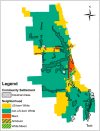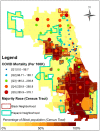Lessons (Not) Learned: Chicago Death Inequities during the 1918 Influenza and COVID-19 Pandemics
- PMID: 37047864
- PMCID: PMC10094019
- DOI: 10.3390/ijerph20075248
Lessons (Not) Learned: Chicago Death Inequities during the 1918 Influenza and COVID-19 Pandemics
Abstract
During historical and contemporary crises in the U.S., Blacks and other marginalized groups experience an increased risk for adverse health, social, and economic outcomes. These outcomes are driven by structural factors, such as poverty, racial residential segregation, and racial discrimination. These factors affect communities' exposure to risk and ability to recover from disasters, such as pandemics. This study examines whether areas where descendants of enslaved Africans and other Blacks lived in Chicago were vulnerable to excess death during the 1918 influenza pandemic and whether these disparities persisted in the same areas during the COVID-19 pandemic. To examine disparities, demographic data and influenza and pneumonia deaths were digitized from historic weekly paper maps from the week ending on 5 October 1918 to the week ending on 16 November 1918. Census tracts were labeled predominantly Black or white if the population threshold for the group in a census tract was 40% or higher for only one group. Historic neighborhood boundaries were used to aggregate census tract data. The 1918 spatial distribution of influenza and pneumonia mortality rates and cases in Chicago was then compared to the spatial distribution of COVID-19 mortality rates and cases using publicly available datasets. The results show that during the 1918 pandemic, mortality rates in white, immigrant and Black neighborhoods near industrial areas were highest. Pneumonia mortality rates in both Black and immigrant white neighborhoods near industrial areas were approximately double the rates of neighborhoods with predominantly US-born whites. Pneumonia mortality in Black and immigrant white neighborhoods, far away from industrial areas, was also higher (40% more) than in US-born white neighborhoods. Around 100 years later, COVID-19 mortality was high in areas with high concentrations of Blacks based on zip code analysis, even though the proportion of the Black population with COVID was similar or lower than other racial and immigrant groups. These findings highlight the continued cost of racial disparities in American society in the form of avoidable high rates of Black death during pandemics.
Keywords: 1918 influenza; COVID-19; black; pandemic; racial disparity; social death; social determinants of health; vulnerability.
Conflict of interest statement
The authors declare that the research was conducted in the absence of any commercial or financial relationships that could be construed as a potential conflict of interest.
Figures




Similar articles
-
Structural Inequality and COVID-19 Mortality in Chicago: An Ecological Analysis.J Racial Ethn Health Disparities. 2023 Dec;10(6):2620-2629. doi: 10.1007/s40615-022-01440-1. Epub 2022 Nov 8. J Racial Ethn Health Disparities. 2023. PMID: 36348182 Free PMC article.
-
COVID-19 and Inequity: a Comparative Spatial Analysis of New York City and Chicago Hot Spots.J Urban Health. 2020 Aug;97(4):461-470. doi: 10.1007/s11524-020-00468-0. J Urban Health. 2020. PMID: 32691212 Free PMC article.
-
Black-White Risk Differentials in COVID-19 (SARS-COV2) Transmission, Mortality and Case Fatality in the United States: Translational Epidemiologic Perspective and Challenges.Int J Environ Res Public Health. 2020 Jun 17;17(12):4322. doi: 10.3390/ijerph17124322. Int J Environ Res Public Health. 2020. PMID: 32560363 Free PMC article.
-
COVID-19 Healthcare Inequity: Lessons Learned from Annual Influenza Vaccination Rates to Mitigate COVID-19 Vaccine Disparities.Yale J Biol Med. 2021 Sep 30;94(3):509-515. eCollection 2021 Sep. Yale J Biol Med. 2021. PMID: 34602888 Free PMC article. Review.
-
Race and 1918 Influenza Pandemic in the United States: A Review of the Literature.Int J Environ Res Public Health. 2019 Jul 12;16(14):2487. doi: 10.3390/ijerph16142487. Int J Environ Res Public Health. 2019. PMID: 31336864 Free PMC article. Review.
References
-
- APM Research Lab The Color of Coronavirus: COVID-19 Deaths by Race and Ethnicity in the US. APM Research Lab. 2020. [(accessed on 25 October 2021)]. Available online: https://www.apmresearchlab.org/covid/deaths-by-race.
-
- Yancy C.W. COVID-19 and African americans. JAMA. 2020;323:1891–1892. - PubMed
-
- McNeely C.L., Schintler L.A., Stabile B. Social determinants and COVID-19 disparities: Differential pandemic effects and dynamics. World Med. Health Policy. 2020;12:206–217. doi: 10.1002/wmh3.370. - DOI
-
- Du Bois W.E.B. The Philadelphia Negro: A Social Study. University of Pennsylvania Press; Philadelphia, PA, USA: 1899.
-
- Downs J. Sick from Freedom: African-American Illness and Suffering during the Civil War and Reconstruction. Oxford University Press; Oxford, UK: 2012.
Publication types
MeSH terms
LinkOut - more resources
Full Text Sources
Medical

